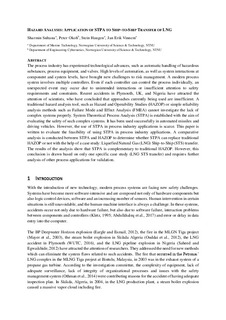| dc.contributor.author | Sultana, Sharmin | |
| dc.contributor.author | Okoh, Peter Ichekani | |
| dc.contributor.author | Haugen, Stein | |
| dc.contributor.author | Vinnem, Jan Erik | |
| dc.date.accessioned | 2019-11-18T12:22:03Z | |
| dc.date.available | 2019-11-18T12:22:03Z | |
| dc.date.created | 2019-05-31T19:15:15Z | |
| dc.date.issued | 2019 | |
| dc.identifier.citation | Journal of Loss Prevention in the Process Industries. 2019, 60 241-252. | nb_NO |
| dc.identifier.issn | 0950-4230 | |
| dc.identifier.uri | http://hdl.handle.net/11250/2629029 | |
| dc.description.abstract | The process industry has experienced technological advances, such as automatic handling of hazardous substances, process equipment, and valves. High levels of automation, as well as system interactions at component and system levels, have brought new challenges to risk management. A modern process system involves multiple controllers. Even if each controller can control the process individually, an unexpected event may occur due to unintended interactions or insufficient attention to safety requirements and constraints. Recent accidents in Plymouth, UK, and Nigeria have attracted the attention of scientists, who have concluded that approaches currently being used are insufficient. A traditional hazard analysis tool, such as Hazard and Operability Studies (HAZOP) or simple reliability analysis methods such as Failure Mode and Effect Analysis (FMEA) cannot investigate the lack of complex systems properly. System Theoretical Process Analysis (STPA) is established to evaluate the safety of such complex systems. It has been used successfully in automated missiles and driving vehicles. However, the use of STPA in process industry applications is scarce. This paper is written to evaluate the feasibility of using STPA in process industry applications. A comparative analysis is conducted between STPA and HAZOP to determine whether STPA can replace traditional HAZOP or not with the help of a case study: Liquefied Natural Gas (LNG) Ship-to-Ship (STS) transfer. The results of the analysis show that STPA is complementary to traditional HAZOP. However, this conclusion is drawn based on only one specific case study (LNG STS transfer) and requires further analysis of other process applications for validation. | nb_NO |
| dc.language.iso | eng | nb_NO |
| dc.publisher | Elsevier | nb_NO |
| dc.rights | Attribution-NonCommercial-NoDerivatives 4.0 Internasjonal | * |
| dc.rights | Attribution-NonCommercial-NoDerivatives 4.0 Internasjonal | * |
| dc.rights.uri | http://creativecommons.org/licenses/by-nc-nd/4.0/deed.no | * |
| dc.rights.uri | http://creativecommons.org/licenses/by-nc-nd/4.0/deed.no | * |
| dc.title | Hazard analysis: Application of STPA to ship-to-ship transfer of LNG | nb_NO |
| dc.type | Journal article | nb_NO |
| dc.type | Peer reviewed | nb_NO |
| dc.description.version | acceptedVersion | nb_NO |
| dc.source.pagenumber | 241-252 | nb_NO |
| dc.source.volume | 60 | nb_NO |
| dc.source.journal | Journal of Loss Prevention in the Process Industries | nb_NO |
| dc.identifier.doi | 10.1016/j.jlp.2019.04.005 | |
| dc.identifier.cristin | 1701973 | |
| dc.description.localcode | © 2019. This is the authors’ accepted and refereed manuscript to the article. Locked until 9.4.2021 due to copyright restrictions. This manuscript version is made available under the CC-BY-NC-ND 4.0 license http://creativecommons.org/licenses/by-nc-nd/4.0/ | nb_NO |
| cristin.unitcode | 194,64,20,0 | |
| cristin.unitcode | 194,63,25,0 | |
| cristin.unitname | Institutt for marin teknikk | |
| cristin.unitname | Institutt for teknisk kybernetikk | |
| cristin.ispublished | true | |
| cristin.qualitycode | 1 | |

